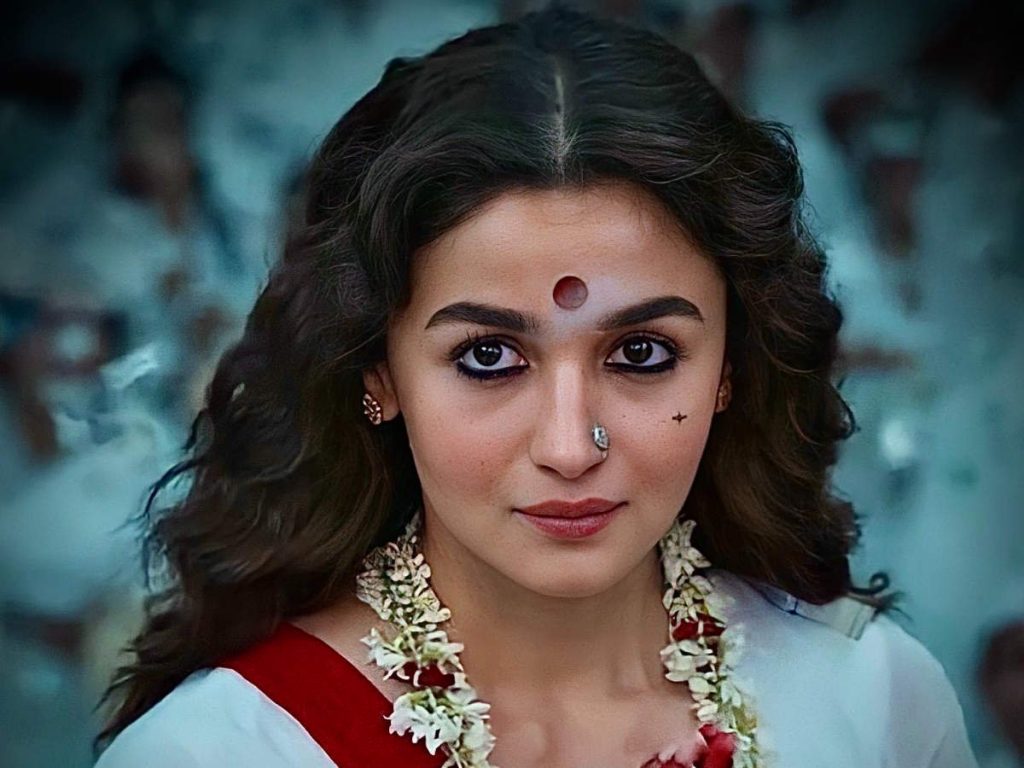Set in the 1950s and ’60s, Sanjay Leela Bhansali’s Gangubai Kathiawadi (2022) charts the struggle, survival and finally, the rising above the odds of a young girl, Ganga, thrown into the flesh trade in Mumbai’s red light area, Kamathipura. With its precise eye for detail, opulent production design, sumptuous visuals and a kick-ass central act, Gangubai Kathiawadi has its share of moments that lift the viewer into a state of cinematic exaltation. Ultimately however, the lack of depth in its writing fails to create a strong enough narrative and this lets the film down majorly. It proves yet again that the best of technicalities cannot save a film if its content is weak.
The film looks at the travails of Ganga Harjivandas (Alia Bhatt), the daughter of a barrister from Kathiawadi. She harbors starry-eyed dreams of becoming a leading lady in Hindi cinema and elopes with her lover, Ramnik (Varun Kapoor), to the maximum city, hoping to make her dreams come true. Ramnik, however, sells her to a brothel in Kamathipura. Forced into the business of prostitution, the young Ganga earns fame with the soubriquet Gangubai. Things take a turn when one night, brothel madam Seemabai (Seema Pahwa) sends Gangu to a sadistic customer, who brutally rapes her. In retaliation, Gangu seeks help from the local don, Rahim Lala (Ajay Devgn), leading to a kinship developing between them. With his help, the feisty and no-nonsense Gangu takes control of the brothel after Seemabai’s death and as her popularity in the area soars, she defeats trans woman Raziabai (Vijay Raaz) in a local election to wield considerable political clout as well…
As with any Bhansali film, Gangubai Kathiawadi is mounted lavishly. From the minutest of details in the production design to his extremely evocative lensing, Bhansali’s capturing of the film’s period and mood is impeccable. There are sequences that speak of high cinematic brilliance such as the romantic moments between Gangu and the tailor, Afshan Razak (Shantanu Maheshwari). But for all its aesthetic and technical highs, the writing is weak as Bhansali and his co-writer, Utkarshini Vashishtha, fail to construct an engaging and layered screenplay. The storytelling is choppy, too many scenes are loosely knitted and the film’s various socio-political issues remain superficial and on the surface. In particular, Gangu’s key transformation from an innocent young girl to a hardened-aware-of-the-ways-of-
It is Alia Bhatt who gives the film much of its heft. Playing a fiercely combative woman with a razor-sharp indomitable spirit, she is spot on as her Gangubai is unapologetic, sharp-tongued and fiery. Bhatt goes a step further, infusing her with rare intensity and more importantly, much dignity. With the film totally focusing around Gangubai, most of the supporting cast suffer from sketchy characterizations, entering the plot from out of the blue and then vanishing. But being fine actors, Seema Pahwa, Ajay Devgn, Vijay Raaz, Jim Sarabh and Indira Tiwari all do full justice to their characters in the limited screen time they have. Shantanu Maheshwari makes a confident enough debut and though there is a certain stiffness in parts of his performance, his sincerity balances his shortcomings.
Technically, the film is a triumph for its crew. The cinematography by Sudeep Chatterjee and production design by Subrata Chakraborty and Amit Ray work in tandem beautifully to create the spectacular look and feel of the film. Chatterjee captures the rich tapestry of the period with a soft and saturated colour palette while his lighting enhances the mood of the story, encompassing the actors with a sense of warmth. The exquisite and fluid long takes traversing through the interior locales add much charm even as they help us step into the shoes of the characters. The editing by Rajesh Pandey, though defeated at times by the uneven flow of the screenplay, enhances the emotional and dramatic tone of the film. The background score by Ankit and Sanchit Balhara creates moments of elation, tenderness and sadness with equal ease that smoothly blend with the emotion of the scenes. The sound design by Sanal George brings out the delicate balance between the dialogue, ambience and background music perfectly. The dialogues (Prakash Kapadia and Utkarshini Vashishtha) are filled with enough whistle-inducing and clap-reverberating moments and provide much strength to some of the dramatically persuading moments of the film. However, song picturization, usually a highpoint of all Bhansali films, is disappointing here. It is just a rehash from his previous films.
Gangubai Kathiawadi relies heavily on the strength of Alia Bhatt’s powerhouse performance and the considerable virtuosity of its technical team to create a spectacular looking film. If only the writing, too, held up as well, the film would have been an exhilarating experience. As it is, it has its highs but they fail to add up satisfactorily to a whole.
Hindi, Drama, Color
https://www.youtube.com/watch?v=N1ZwRv3vJJY


